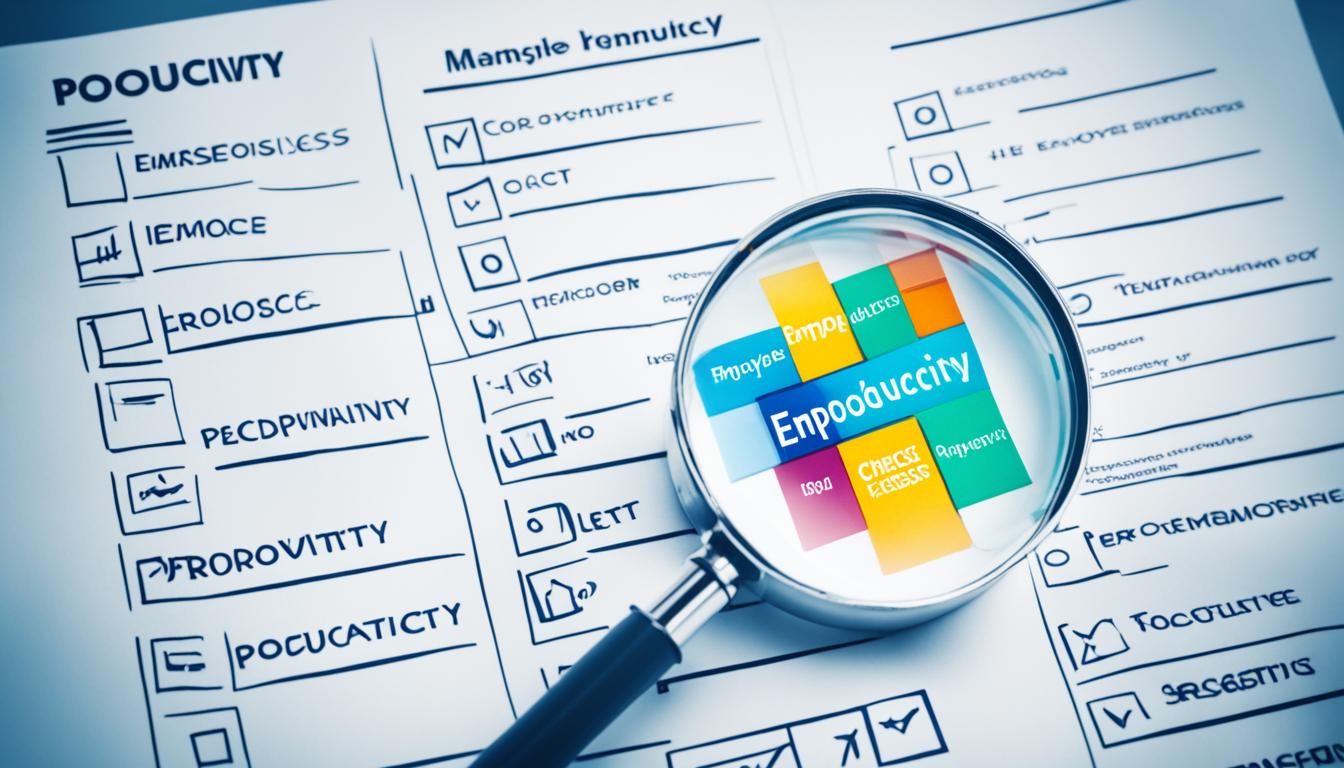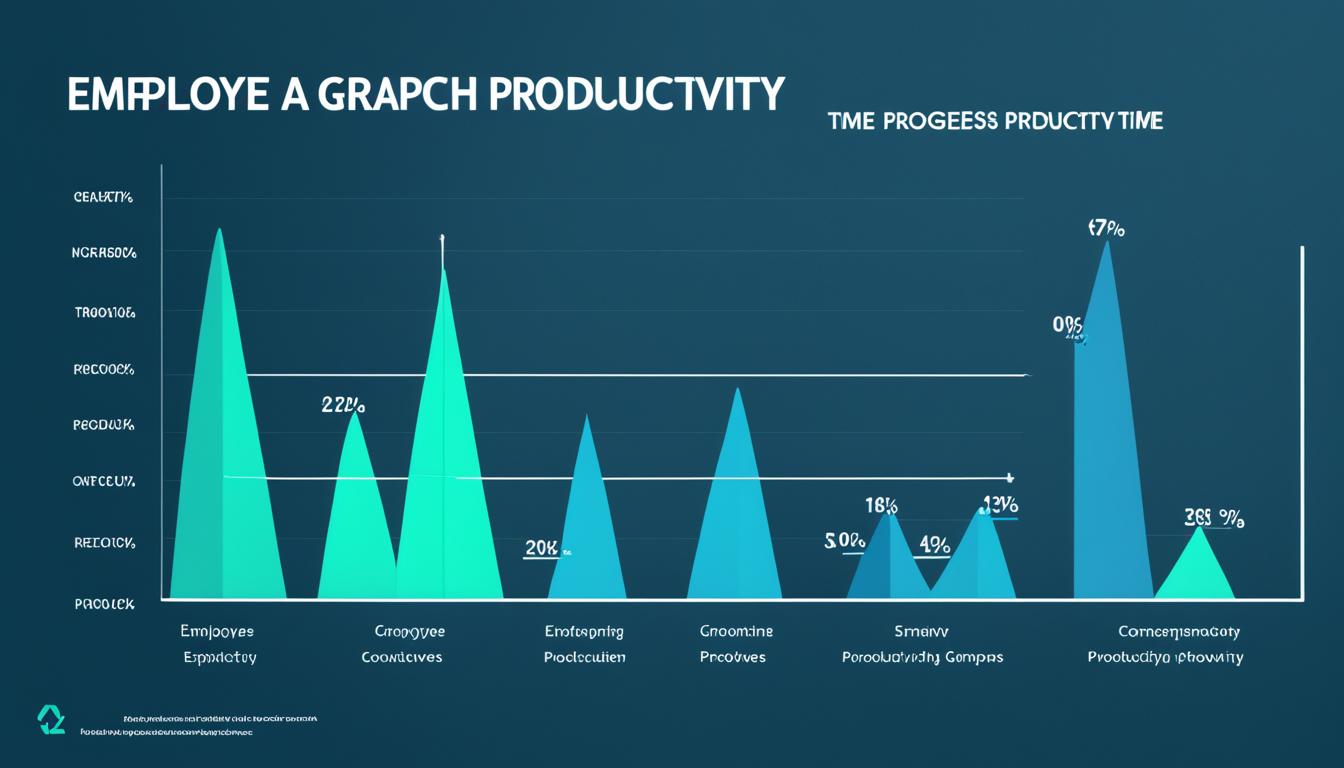A detailed employee productivity checklist is key for performance evaluation. It helps match an employee’s work with the company’s goals. Most companies do employee assessments once a year. These reviews are crucial for checking how much an employee helps the company succeed.
By planning and doing these reviews well, managers can build a team that works efficiently. Using an Employee Productivity Checklist makes these reviews more than just HR tasks. It turns them into key steps for growing both the employee and the company.
This checklist helps managers keep track of what employees achieve. It also helps them give good feedback, set clear goals, and keep communication open. Emphasizing communication skills in these evaluations ensures that employees can convey thoughts clearly and foster a positive working environment. It makes sure employees know what’s expected of them. It also helps with regular checks and planning for the future, which boosts the company’s productivity.

Key Takeaways
- Regularly conducted performance evaluation can significantly impact bonuses and promotions.
- Utilizing a checklist helps in setting SMART goals and maintaining continuous growth.
- Ongoing feedback and open conversations enhance employee engagement.
- Avoiding comparisons among employees fosters a positive work environment.
- Encouraging training programs and career development discussions benefit overall productivity.
Plan the Employee Evaluation
Planning for employee evaluations is key. It’s important to make sure the review is helpful and useful. A Detailed Evaluation gives a clear view of how an employee is doing. This helps with growth and getting better. A structured performance review process ensures transparency, objectivity, and consistent feedback, leading to more constructive evaluations.
Here are steps to plan an employee evaluation well:
Be Prepared with Detailed Review
Getting ready for an Employee Performance Review is vital, and using a performance review checklist can greatly aid in this preparation. Managers should set aside at least one hour for the meeting. They should also avoid any interruptions during the review.
It’s good to have a list of what’s expected and talk about past goals. Giving employees what they need to reach their goals helps a lot. Looking at attendance and past work lets managers give feedback that’s right on point.

Begin with Positives
Starting with the good stuff and acknowledging a positive attitude sets a positive tone. Saying thanks for what employees do well makes them feel important. Praise for specific things they’ve done right motivates them and encourages good habits.
This makes the rest of the review go better.
Offer Constructive Feedback
After starting with the good, it’s time for feedback that helps them improve. A good Feedback Mechanism balances praise with what needs work. This helps employees see how they can get better at their jobs.
Talking about work goals and skills gives them a clear direction. If there’s not enough time for all goals, having another meeting is a good idea. This makes sure everything important gets talked about.
Document Employee Achievements and Shortcomings
It’s key to keep track of both good and bad points during performance checks to accurately assess an employee’s performance. Keeping records all year makes sure the review is fair and full of facts. These records should cover big wins, finished projects, hitting targets, and areas to get better at.

Keep Regular Records
Writing down what employees do helps keep track of their wins and areas to work on. Keeping records up to date shows how they’re doing over time. It helps spot where they need to keep getting better.
This way, it’s easier to see what they’re doing great at and where they can improve. Keeping records helps make talking about performance easier.
Review During Appraisal
Looking at these records during a performance appraisal is very important. It helps make sure the review is fair and looks at everything clearly. The records should talk about important skills, how projects went, and what training is needed.
Using these records makes it clear the company is serious about getting better and being responsible. This helps make sure everyone is happy and the company meets its goals. The human resources department plays a crucial role in ensuring fair and systematic evaluations by verifying the merit of employee nominations against a criteria checklist, thus avoiding favoritism.
SMART Goals
Setting SMART goals is key for clear, reachable goals that match company plans. The SMART Criteria include Specific, Measurable, Achievable, Relevant, and Time-Bound. These elements help make good goals. Using SMART Criteria can boost team work and track progress better. Additionally, setting SMART goals significantly contributes to the company’s success by aligning employee efforts with organizational objectives.

Set Specific and Measurable Objectives
Clear and measurable goals give a direct aim for employees. For example, adding 1,000 new users to a mobile app each month is a clear goal. Tools like goal tracking apps help keep an eye on progress. This makes it easier to check how well we’re doing and change plans if needed.
Specific goals help team members know what to focus on.
Ensure Goals are Attainable
Goals must be realistic, fitting the employee’s role and resources. They should match the team’s skills and budget. This balance keeps motivation high and helps achieve success. A structured Goal-Setting Strategy helps set goals that are doable and right for growth.
Evaluate Progress Regularly
Checking progress often is key for good performance and adjusting plans. Regular reviews of SMART goals help spot support needs or changes in strategy. This evaluation keeps the team moving and in line with big goals. It keeps everyone clear on the path to success and keeps them engaged.
Honest Conversations and Transparency
Talking openly between managers and workers builds trust and openness. Almost 4 in 10 U.S. workers say their managers don’t often talk honestly about work. It’s key to fix this gap. Open talks can make workers happier, more engaged, and more productive. Honest conversations also contribute significantly to enhancing the company’s culture.

Encourage a Two-Way Dialogue
It’s vital to make sure workers feel heard. By talking back and forth, managers show they care about what workers say. This way, everyone gets a say, making discussions richer and more complete.
Explain the Assessment’s Objective
Telling workers why an assessment is done helps them see its value. It’s not just a check-up. It’s for finding skills to improve, making jobs better, and helping workers grow in their careers. This makes workers see how they help themselves and the company.
In short, using open talks and clear goals makes trust and motivates workers. When workers are part of honest talks, they grow and work better together towards company goals.
Set a Performance Standard
It’s key to set clear goals to improve employee performance. These goals should be easy to understand and match the job they do. This way, workers know how to measure their work and aim for success.

Develop Clear and Achievable Standards
Creating clear goals and benchmarks is important for managing work. When goals are clear and reachable, workers know what’s expected. This makes it easier to set goals they can work towards.
Using a review schedule and reminders helps managers get ready for check-ins. This makes the review process smooth and organized.
Compare Performance Against Standards
Regular checks on how well employees are doing are key. By looking at how they stack up against set goals, managers can fairly judge their work. This helps in checking how well teams and workers are doing.
Doing reviews often and in a standard way makes things fair and clear. It helps everyone work towards better performance and growth.
Ongoing Feedback Process
Getting regular feedback is key to getting better at what we do and to motivate employees. When feedback is given often, it’s specific, and it tells us what to do next, it really helps. 65% of employees want more feedback. This shows how important it is to have a place where feedback is shared a lot.

Offer Daily Suggestions
Getting feedback every day helps improve or change how employees work right away. This quick feedback helps them change their ways quickly. Giving feedback every day is great for getting better little by little, without waiting for a big review.
Conduct Regular Check-Ins
Checking in often is more than just talking about work. It’s a chance to adjust goals and what’s expected. These meetings show that keeping up with performance is always important, not just once a year.
Checking in often gives feedback that keeps us moving forward. It also makes employees feel important and heard. This way, they feel connected to the company’s goals. And, 4 out of 10 employees say they feel left out without feedback.
These meetings also help managers understand what the team is facing. They can then give the right help and advice. By focusing on regular feedback, companies can keep their teams ready to improve and do well.
Open Conversations
Open talks during employee reviews are key to a two-way feedback loop. Managers and employees both share their views. This dialogue lets employees talk about their work and what they see in the team and their own challenges. Managers learn about the team’s problems and dreams.

Giving employees a chance to speak up makes performance reviews more inclusive. It shows how the team works together. This makes workers feel more connected and happy in their jobs by listening to their employee voice. Talking openly during performance reviews leads to better and more useful feedback.
Research shows that 70% of workers say 1-on-1 meetings are key for doing well and growing. Also, 85% of bosses think making these meetings personal helps workers do better and stay engaged. This shows why managers should have regular one-on-one talks. These talks help the team work better, stay motivated, and feel connected through dialogues.
Using ongoing feedback, like real-time comments and regular meetings, helps with growth. Weekly chats and personal performance reviews keep communication flowing well. This way of working matches the best ways to help employees grow, showing how quick feedback helps with doing better.
To solve conflicts, it’s important to ask questions, listen, stand up for people, and solve problems. Being supportive, curious, and focused helps make talks more effective. Books like “Difficult Conversations” and “Crucial Conversations” give great advice on these topics.
Starting conversations with good questions can help teams work together better, even when they disagree. Studies show that 65% of workers like it when bosses offer chances to learn new skills and grow in their careers during these talks. This shows how important dialogue is for a better workplace.
Never Compare Employees
Performance reviews should focus on Individual Assessment and Standardized Evaluation. This avoids a toxic work environment. Comparing employees can lead to unhealthy competition and resentment. Instead, a Non-Comparative Review looks at each person’s own achievements and growth. It values everyone’s unique journey and encourages Healthy Competition without stress. Additionally, implementing an employee recognition program can further highlight individual achievements and enhance team morale.
Avoid Toxic Environment
Comparing employees can make them feel bad and lower morale. Managers should give feedback that highlights each person’s strengths and areas to improve. They should not compare them to others. Studies show 95% of employees dislike their reviews because of unfair comparisons. Eduflow fixes this by reviewing performance every quarter and tracking progress.
Focus on Standardized Expectations
A Standardized Evaluation system is key for fairness and clarity in reviews. Using the same rubric for everyone helps measure progress and growth. Managers and employees use the same scales for reviews, ensuring fairness and consistency. This approach improves communication and sets clear goals. It also helps in deciding on promotions, raises, and retention without expecting perfection.
AspectRegular EvaluationsQuarterly ReviewsFrequencyOnce a yearEvery quarterProject InclusionNot specifiedAll projects includedFeedback TypeManager and Self-EvaluationIndividual and Manager EvaluationsGoal SettingAnnualQuarterly with immediate feedback
Setting clear, achievable goals for each employee boosts job satisfaction and productivity. Regular feedback based on clear standards leads to better performance. The goal of reviews is to help employees grow and succeed, creating a positive workplace.
Inculcate Learning Paths & Training Programs
Adding structured learning paths and training programs to employee reviews helps with Professional Development and Skills Enhancement. It finds learning chances and needed skills for growth. This helps meet both employee and company goals. It shows the company cares about employee Career Progression and staying with the company. Human resources play a crucial role in professional development and skills enhancement by providing constructive feedback and ensuring fair recognition of employees’ contributions.
Identify Skills for Development
First, find the key skills needed for each job in the company. Using learning paths gives a clear path, guiding employees through steps of learning. This helps spot Skills Enhancement chances for growth of individuals and teams.
Implement Suitable Courses
After finding skills, it’s key to offer the right Training Opportunities. Linear paths help learn basics before moving to harder topics. Self-directed paths let employees learn at their own pace, fitting their style and what they already know.
Invest in Employee Growth
Using tech like AI can make learning paths personal by looking at how well learners do and changing the path as needed. Investing in top-notch content and building these paths in an LMS shows a company’s commitment to ongoing Professional Development and Skills Enhancement. This leads to a culture of always getting better, helping employees move up in their careers.
This full approach to learning and growth has many benefits. It includes structured training, goal-focused learning, and makes things run smoother. Plus, with 76% of employees saying ongoing training makes them want to stay, investing in training boosts performance and keeps employees happy and around longer.
Benefits of Structured Learning PathsSurvey StatisticsStructured Training Programs89% of employees agree that investing in learning benefits the workplaceGoal-driven Learning46% of L\&D leaders report escalated skill shortagesAdministrative EfficiencyOrganizations prioritizing training are 59% more likely to growAdaptability to Change72% of employers see training as essential for technological adaptation
Communicate with Peers
Talking with coworkers is key to a good employee review. Using peer feedback brings different views. These views are great for seeing how well a team member works with others and gets along.
Getting team input from everyone in the company gives managers a full picture of an employee’s work. This way, managers can see what the employee does well and what they can do better.
Having a clear way to get collaborative evaluation makes sure feedback is full and fair.
- Reduces communication barriers, which have been shown to cost organizations up to $37 billion per year.
- Boosts employee and client happiness by using many different views.
- Makes the workplace better and keeps employees happy and working well.
- Helps build a positive work culture, which is key for good communication.
Using peer feedback tools like 360-degree feedback and team reviews gives a clear view of how well someone performs and gets involved. This keeps the team motivated and productive.
Focus on the Future
Looking ahead is key in employee reviews. It makes sure Employee Aspirations and the Company Vision match. Managers talk openly with employees to show how they fit into big goals. This makes planning for the future a team effort. Aligning employee aspirations with company culture is also crucial for fostering a positive and collaborative workplace environment.
Discuss Career Path
Knowing where an employee wants to go is vital for Career Planning. Managers should talk about their long-term goals and growth chances in the company. Talking about career paths motivates employees. It also helps match their growth plans with their dreams and the Company Vision.
Align with Company Objectives
Matching personal goals with company goals is important. Managers must make sure employees’ goals match the business aims. This alignment gives employees a clear purpose and direction. It makes them feel important to the company’s future.
Encourage Employee Engagement
Being engaged comes from good Career Planning and Goal Alignment. When employees see how they help the Company Vision, they get more involved and motivated. Encouraging them to take part in projects makes them feel needed and important to the company’s success.
Productivity Checklist
A productivity checklist helps both employees and managers keep track of work efficiency. It’s a guide that lists important steps and helps manage tasks and goals. This tool is key for good performance reviews, making sure work is well-organized and productive. Additionally, using a recognition tool can enhance productivity by fostering a supportive and collaborative company culture.
Using a checklist can make work better, cut down on mistakes, and keep things tidy. It’s good to make your checklist simple, focus on the most important things, and keep it easy to follow. Always check and update it, stay on track, and work together as a team. Here are some key facts for a great productivity checklist:
- Sleep loss can make you less productive by up to 11 days a year.
- About 23% of remote workers say they work better at home.
- Short breaks can boost productivity by up to 12%.
- Trying to do too many things at once can cut productivity by 40%.
- A messy desk can make you 15% less productive.
- Setting clear goals can make you 50% more productive.
- Meditation can increase productivity by up to 20%.
- Good time management can save 2 hours a day for top performers.
Here’s what to put in a good productivity checklist:
ComponentDescriptionTask ListLists all tasks clearly for better management.SequenceOrders tasks in a logical order for better efficiency.Categories/SectionsGroups tasks into categories for better task management.CheckboxesHelps mark tasks as done for a feeling of achievement.InstructionsProvides clear steps to finish tasks.Responsible PartiesShows who is in charge of each task.Due DatesShows when tasks must be finished to meet deadlines.DependenciesPoints out tasks that depend on each other to avoid delays.Notes SectionAllows for extra comments or instructions.Progress TrackingKeeps an eye on how tasks are coming along.
Using productivity tools like apps and scheduling software can also help. They make sure every part of the checklist is followed and done well.
Conclusion
In conclusion, the importance of feedback and continuous improvement cannot be overstated. This approach boosts employee productivity and job happiness. It also helps your organization succeed.
Setting clear goals and using tools like the Pomodoro method can really help. Managing distractions and taking breaks are also key. These tips are found in resources like this productivity checklist.
Checklists have changed a lot in the digital age. They make routines more organized and help reduce stress. For more on how to use checklists today, check out this daily productivity checklist.
Always review and adjust your checklists based on what works and what doesn’t. This is important for ongoing growth, as explained in this guide on checklists.
FAQ
What are the essential elements of a comprehensive employee productivity checklist?
A good checklist includes things like keeping track of what employees achieve. It also means giving them regular feedback. And setting clear goals that are Specific, Measurable, Achievable, Relevant, and Time-bound. A well-structured rewards program can also play a crucial role in motivating employees by recognizing their achievements and fostering a positive workplace culture.
It’s important to keep communication open and clear. Also, having clear standards for performance is key. Regular checks and feedback help make sure evaluations are accurate.
And, it’s good to encourage growth and looking towards the future.
How often should employee assessments be conducted to ensure accurate performance evaluation?
Companies usually check on employees once a year. But, having regular chats and feedback helps make these checks more accurate and useful.
Why is documentation important in employee performance reviews?
Keeping records helps review an employee’s work fully. It looks at what they’ve done well, their achievements, and what they need to work on. This makes reviews fair and based on facts, helping everyone improve.
What is the SMART criteria for goal setting?
SMART means Specific, Measurable, Achievable, Relevant, and Time-bound goals. Goals set this way are clear and focused. They match what the employee needs to do and what the company wants.
This makes checking on progress easier and more meaningful.
How can managers foster honest conversations and transparency during evaluations?
Managers can make sure feedback is a two-way street. They should explain why they’re checking on employees. And they should build a trustful work environment.
This makes evaluations seen as a chance to grow and improve.
What role does ongoing feedback play in performance management?
Feedback keeps performance management strong by giving quick help or advice. Regular meetings let managers and employees adjust goals and expectations. This makes managing performance a constant effort.
How should performance standards be communicated to employees?
Standards should be clear, reachable, and match the job. Telling employees what’s expected helps them know what to aim for. This makes sure everyone is on the same page.
It also makes reviews fair and based on clear criteria.
Why is it important to avoid comparing employees during performance reviews?
Comparing people can make work toxic and lead to bad competition. Focusing on each person’s wins and growth makes things fair and healthy. It helps everyone work better together.
How can targeted training programs benefit both employees and the organization?
Training programs pinpoint key skills for growth. They help make plans for development and use resources well. Investing in training boosts performance and shows the company cares about its people.
It also makes employees more motivated and loyal.
What is the significance of peer feedback in performance evaluations?
Feedback from coworkers gives different views on teamwork and how well someone gets along with others. It gives a full picture of an employee’s impact. This makes reviews fair and shows how well the team works together.
How can performance evaluations align with an employee’s career path and company objectives?
Reviews should look at career paths and future projects. They should show how an employee’s goals fit with the company’s goals. This keeps employees engaged and helps the company succeed.
What role does a productivity checklist play in performance reviews?
A checklist is a tool that lists important things to check. It helps track and improve work efficiency. It makes sure reviews are thorough and focused on making work better.

More Posts
7 Best Digital Personal Planners for Every Budget
Managing our everyday tasks, meetings, and goals has become increasingly difficult in the digital age. Fortunately, multiple budget digital planner apps help you stay organized and productive. Whether you prefer the simplicity of...
Effective time management for college students
Atomic Habits by James Clear - book summary
James Clear’s Atomic Habits quickly became a bestseller after its release. It appeared on several notable lists, including the New York Times’ and USA Today’s top rankings. Clear’s work stands out by focusing...
7 Strategies to Create Your 3 Month Study Plan
A good study plan for three months is a big help for school. It lets you use your time well and keeps you on track. This is key for big tests or a...